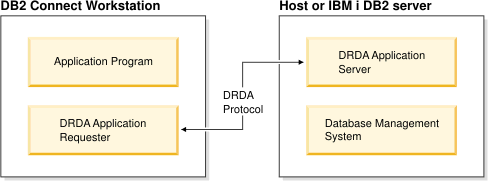DB2 Connect™ implements the DRDA® architecture to reduce the cost and complexity of accessing data stored in IBM® DB2® for IBM i, DB2 for IBM Power Systems™, DB2 for z/OS®, DB2 Server for VM and VSE, and other DRDA-compliant database servers. By fully exploiting the DRDA architecture, DB2 Connect offers a well-performing, low-cost solution with the system management characteristics that customers demand.
In DRDA terminology, an application requester (AR) is the code that handles the application end of a distributed connection. The AR is the application that is requesting data. DB2 Connect acts as an application requester on behalf of application programs which can be local to the DB2 Connect workstation or on a separate client remote to DB2 Connect.
An application server (AS) is the code that handles the database end of the connection.
DRDA also supports multi-tier connections between an application requester and a server. In this topology, the server that an application requester connects to is an application server, but any other server further downstream is called a database server (DS) as it does not interact directly with the application requester. In addition, to highlight its role as neither the system where a database request originates nor the system that performs the database function for the request, each application server or database server between an application requester and the final database server is also called an intermediate server. The use of database servers and intermediate servers is supported by DB2 Connect.
Figure 1 shows the flow of data between the DB2 Connect workstation and the IBM mainframe server in the case where there are local clients only.

These architectures are used as building blocks. The data streams which flow over the network are specified by the DRDA architecture which documents a data stream protocol supporting distributed relational database access.
A request is routed to the correct destination by means of directories that contain various types of communication information and the name of the DRDA server database being accessed.